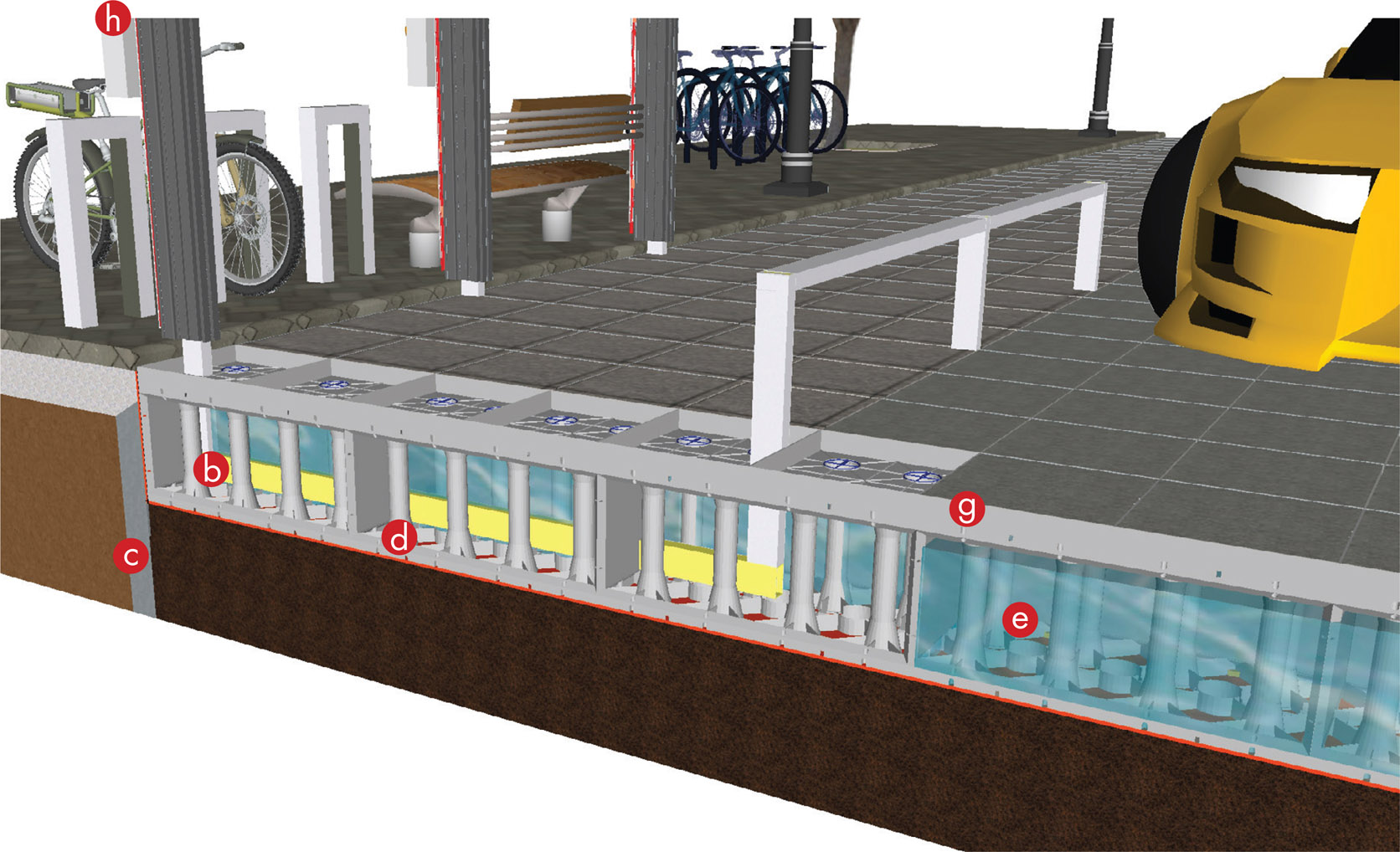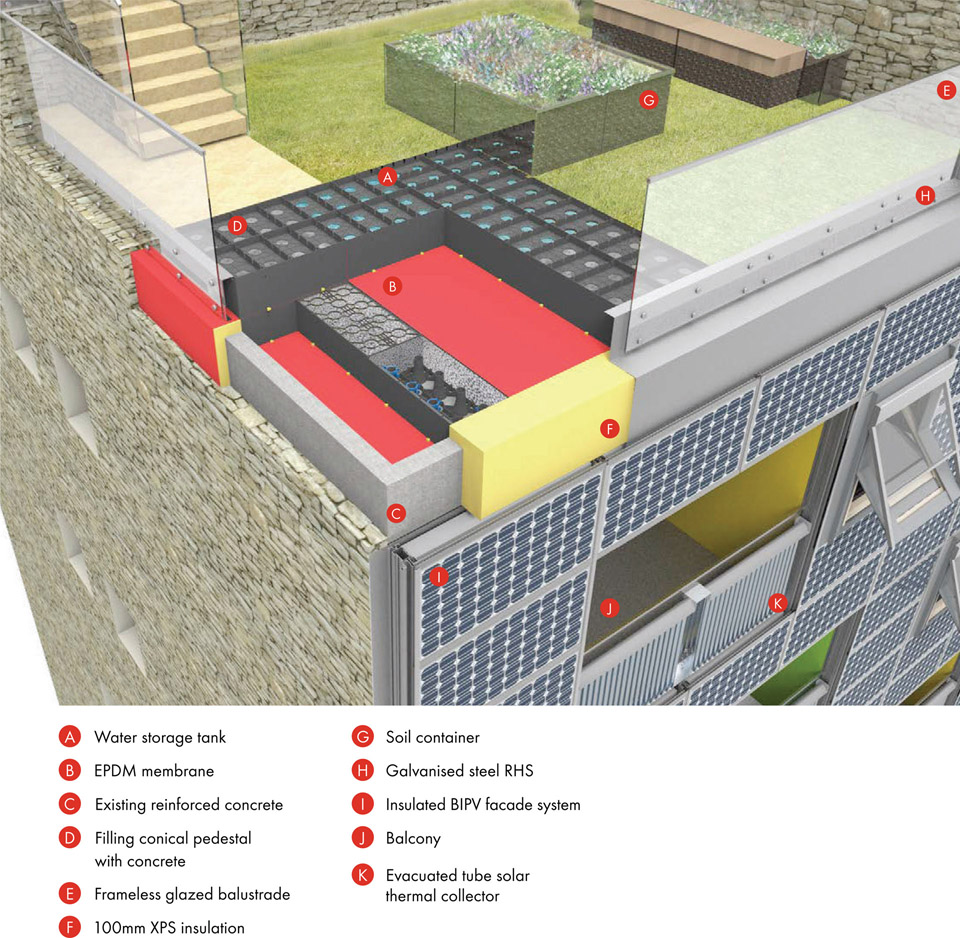Chapter Nine
Tool 7
Rainwater Harvesting and Water Re-Use
Water scarcity is a major problem today, with around 1.7 billion people living in places with a serious scarcity.12 This number will only rise as populations grow, while negative climate change reduces access to water. For climates with more rainfall, the value of storing rainwater becomes clear when trying to build an environment that revolves around having zero-carbon emissions. It is simply madness to be transporting filtering and treating water simply to flush it down the toilet when gravity-fed rainwater could do the job just as well without needing additional energy. The need to use water sensibly, and to save as much as possible, becomes ever more obvious, and decentralisation is the best way to achieve it.
Rainwater harvesting means catching and storing rainwater in tanks inserted within a building. Unfiltered, this water can be used for basic applications such as toilet flushing, clothes washing and garden irrigation. When filtered, the water can then be used for showering and catering.
Benefits of a rainwater harvester
- Capturing water directly saves building users the costs of consuming water delivered by the mains.
- Reducing the stress on dams and reservoirs water reduces the energy needed for what comes out of the tap.
- Storing rainwater and releasing it slowly decreases the damage of flash floods after sudden and heavy storms.
- Storing water this way means saving money on increasing drainage systems capacity.
- Harvesting systems ensure that all available water in the area is used before any needs to be pumped from already over-exploited wells and rivers.
Water re-use
Recycling does not apply just to waste and rubbish, but also to water, which can be recycled safely and sensibly. Grey water – draining from showers, bathtubs and sinks – can be reused for toilet flushing and gardens after light treatment, but should not be used for cooking or drinking, as additional treatment is required.
In the area around a development, grey water can be used for farming and landscape irrigation, topping up waterscapes and artificial lakes. It can also contribute to the water requirements of the construction process, including concrete mixing, pressure washing and dust control.
There are cost savings all along the line, using less energy to bring water to the site for uses other than drinking, and dramatically reducing the cost of waste-water drainage. These benefits in turn help to maintain the ambient environment by protecting delicate freshwater ecosystems from contamination and also from being drained for uses that can be offset.
The ZED water surface
This new proposal by ZEDfactory enables a rainwater tank to be created from the large expanses of concrete found across all of our cities in the forms or roads, pavements and parks, potentially a huge volume for storage. As concrete is a porous material, water can be stored within the structure of the pavement without restricting the stability of the surface.
We propose this partly because the conventional solution of polypropylene cellular rainwater storage tanks is so unsatisfactory. They require large wall thicknesses for strength and one metre of topsoil cover. Their life expectancy is only 25 years, after which they become brittle and eventually fail under high loads, so that beautiful and expensive mature landscape has to be dug up and remade.

9.1
Diagram illustrates the internal load-baring insulated water storage foundation system.
Load-bearing foundation system with heating and cooling storage
ZED has seen the potential for the water-holding polypropylene cones within the tank structure to act as permanent shuttering for poured concrete, which then takes compressive load, so that brittleness ceases to be a limitation. Apart from avoiding the cost and disruption of remaking the installation every 25 years, the concrete base could be adapted with foundation pads to carry a superstructure. If a cementitious floor tile or paving slab rides directly on top of the cellular tank, that means less excavation and lower earthmoving costs.
By filling the cellular tanks with blown EPS bead insulation, they would act as a storage sink by retaining heat in winter and staying cool in summer (fig. 9.1). A polybutylene underfloor heating/cooling coil could transmit heat or coolth from an external heat pump into the insulated rainwater store, increasing the levels of energy stored in the water. Heating and cooling equipment adapted to this system would no longer need to meet peak loads, so could be smaller and run off solar energy.
Permeable street surface with integral drainage and rainwater thermal storage system
How does the water get into the system? ZEDfactory proposes a removable polypropylene paving system that sits directly on top of the concrete-filled tank cones. The paving system could be filled with porous concrete so that water drains directly into the storage tank and large solids are filtered out (fig. 9.2).
In hot, humid climates, many people travel by car to benefit from the air conditioning, but you could walk in comfort along streets shaded by a solar-cooled canopy with integrated water storage. The surface of the paving slab would transmit coolth from the tanks to the walkway under your feet by conduction.
The solar canopy would be fixed to the steel foundation tubes and within it you could make bus shelters, bike shelters and covered walkways, generating enough electricity to power an ice slurry generator pumping chilled water through the cellular storage tanks.

9.2
Road permeate discharge integration system.
Roof garden integrated with water-storage tank
If some of the tanks were filled with concrete, they could provide a firm base for the components needed for a roof garden without needing to penetrate the EPDM (ethylene propylene diene monomer (M-class) rubber)13 membrane tanking, which normally leaks because of handrails and other fixings sticking throught it (fig. 9.3). The roof can have a mixture of paving, rainwater storage and insulation, with rooftop structures such as plant rooms or terrace bars.

9.3
Insulated roof garden with water storage.
